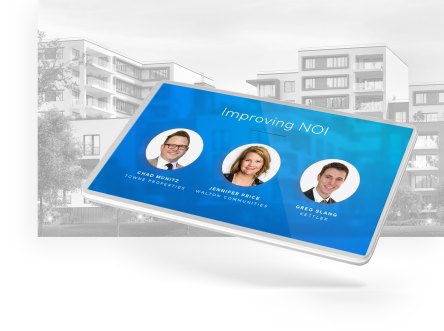If you’re like many multifamily operators, the technology you thought would be “nice to have” became “must have” when COVID-19 hit. With those must-have contactless services and automated transactions in place, companies are now asking, “what’s next?” to move business forward. To answer that question, we talked to Chad Munitz, vice president of development at Towne Properties, Jennifer Price, director of systems at Walton Communities, and Greg Slang, executive vice president of asset management at KETTLER, about the metrics they’re focusing on in 2021, and how it’s shifted the way they do business. The bottom line: They can still improve net operating income beyond rent increases by reducing expenses, increasing efficiencies and leveraging new technology in their operational processes. Keep reading to hear their stories and get some ideas to incorporate in your business. Virtual tours and online leasing According to Munitz, Towne prides itself on being a high touch management company — and technology has increased its capabilities to offer more to its residents. With the onset of the pandemic, Towne quickly provided more contactless services. “When the pandemic started, one of our initial fears was how do we keep those relationships and touches going with all of our residents. It allowed us to figure out the services we wanted to roll out quicker — including allowing people to pay rent online and sign leases digitally. We really started focusing on a centralized leasing and management process and honed-in on some of our urban properties where we were seeing the most negative impacts of the pandemic in terms of revenue. So, we centralized all our leasing and management at one location and implemented technology to support it. We were as in touch with our residents as we were before, and we increased ways...
Moving Forward
Downturn insight for multifamily
Yardi multifamily experts Dhar Sawh, Paul Yount and Patrick Hennessey went in-depth on how industry professionals can best prepare for what’s next in a helpful operational strategies webinar this week. Miss it? You can register for additional sessions here. The hour-long presentation featured both current economic data sourced from Yardi Matrix as well as key takeaways from Yardi’s Downturn Playbook, a comprehensive resource for meeting the challenges ahead. “When we saw COVID-19 hit the U.S. in March, we really saw (multifamily demand) plummet. But we are already seeing that demand bounce back. It’s bounced back, but it has definitely changed,” said Sawh, industry principal at Yardi. Find out more about national multifamily trends in the latest Matrix webinar recording. Preparing for success in the post-COVID-19 multifamily world will involve shifts in the way leasing and operations teams are used to doing business. Examples include: A virtual marketing and leasing experience, from start to finish. “It is critical prospects can get what they need to make a decision when they cross your digital threshold,” said Yount, industry principal at Yardi. That may mean activating aspects of your marketing website that you haven’t used before. Do you have adequate photos, videos and 3-D floor plans? What about the ability to chat live online with a leasing representative? Nudge marketing? Details about how your property has responded to coronavirus is another essential. And the need to fully execute a lease online is more important than ever – many prospects are now willing to consider signing without ever visiting a property in person. The opportunity to take a self-guided tour. Self-guided tours were already growing in popularity before the pandemic, but they now provide an opportunity for contactless viewing and will be likely more popular than ever moving...
Maximize Revenue
Use Data Better
The National Apartment Association (NAA) recently hosted the 2017 Education Conference in Atlanta. Marketing Maneuvers: Data in the Driver’s Seat explores how data can inform marketing decision and maximize revenue. Panelists included Candace Weaver, Director of Marketing, Bell Partners; Diana Norbury, Vice President, Multifamily Operations, Pillar Properties; and moderator Dharmendra Sawh, Industry Principal, Revenue Management and Business Intelligence Sales at Yardi. The trio reinforces the importance of operations, revenue management, and marketing working together to reach goals. Below are three takeaways from the session: Understand the “Magic Mix” Before you can gather data, four key components must be in place to generate web-based data sets: SEO– search engine optimization is how your site is written to interact well with search engines. If you don’t have this solid foundation, you’ll have to work harder and spend more on SEM. Quality SEO contributes to higher organic rankings. SEM– search engine marketing includes paid search features. It is second best to organic rankings. “In one of our properties, there were an average 497 organic views but an average 690 views with paid search. Paid search will boost you but you can’t do SEM well without SEO,” explains Weaver. SEM comes with unique benefits as well. In one Bell case study, only 23 percent of leads came from SEM yet those leads made up 43 percent of total conversions. ORM -online reputation management entails how your brand is perceived online. This includes but is not limited to reviews and comments on your site and third party sites. Both Norbury and Weaver recommend having designated reputation management teams. “Of the 2 percent of people that click ‘Reviews’ on our property website, they have a 46 percent chance of converting,” says Weaver. SMO- social media optimization may overlap with ORM...
Choose Clean Power
Insight from MCEnergy
Evidence of climate change is all around us – for example, the amount of Americans with asthma has more than doubled in the past three decades, and rates are alarmingly high among lower-income people, who are more likely to live near a power plant. It’s no wonder that people are getting sicker when, as a country, we emit more than 5.5 billion tons of carbon dioxide (CO2) a year. As of August 2015, the Obama administration released a proposal to tackle this tremendous issue in the form of the Clean Power Plan (CPP). The plan sets the country’s first-ever national standards limiting carbon pollution from power plants, which were previously unregulated. The CPP aims to reduce carbon dioxide emissions by 32 percent by 2030 by establishing standards, but allowing individual states the flexibility to choose how this should be accomplished. With such a daunting goal, it can be confusing to know where to start when considering alternative energy for your properties. We caught up with Jennifer Burke, an energy consultant at Yardi subsidiary MCEnergy, to find out what this new plan means for the commercial real estate industry. How will the CPP affect commercial real estate? JB: The CPP is intended to reduce carbon emissions by 32 percent for U.S. power plants – below 2005 levels. Coal fired power plants are the greatest emitters of carbon. Therefore, the CPP will have the greatest impact to electricity pricing in geographic areas where coal is more dominant in the generation of electricity. The PJM ISO, the largest Independent System Operator (ISO) in the U.S., which encompasses 13 states in the mid-Atlantic region, has a relatively high concentration of coal fired power plants and will be impacted the most. As more coal plants are retired, there may...




